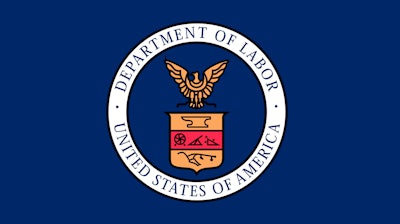
WASHINGTON, DC — The U.S. Department of Labor released the following statement regarding President Donald J. Trump's fiscal year (FY) 2021 budget:
"The President's Budget sets forth the Administration's plan for uplifting America's workers," said U.S. Secretary of Labor Eugene Scalia. "Whether it's expanding access to apprenticeship programs, helping our transitioning service members enter the next phase of their careers, or providing options for paid family leave, the President's Budget creates more opportunity for America's workers to thrive in today's strong economy. And it does so in a fiscally responsible manner that also furthers the Department's enforcement efforts."
The President's Budget makes targeted investments in programs by increasing resources to safeguard working conditions; protecting health benefits, retirement and wages; advancing veterans' career opportunities; and reforming or eliminating unproven, ineffective or duplicative programs.
The FY 2021 discretionary budget request for the Department of Labor is $11.1 billion. This funding, in addition to mandatory investments and reforms, supports the Department's mission to help Americans achieve careers, to protect the safety and financial security of American workers, and to ensure the American workforce can meet the needs of job-creators to sustain economic growth.
FY 2021 Department of Labor Budget Highlights:
- Continues to close the skills gap by investing $200 million in apprenticeships, a proven earn-while-you-learn strategy that prepares workers with the skills and experience needed to fill high-paying jobs in high-demand fields. The budget also proposes to double the American Competitiveness and Workforce Improvement Act fee for the H-1B program in order to support the department's grants to expand apprenticeship in high-growth sectors where apprenticeships are underutilized, such as healthcare, information technology, and advanced manufacturing.
- Invests in our Nation's veterans, transitioning service members, and their spouses by increasing funding for the Veterans' Employment and Training Service. This increase would help support wounded warriors with curriculum tailored specifically to assist service members facing medical separation in their employment situation.
- Includes a proposal to provide six weeks of paid parental leave to new parents, including adoptive parents. This proposal will allow states to establish paid parental leave programs in a way that is most appropriate for their workforce and economy and will give families time to recover from childbirth and bond with a new child.
- Ensures American workers get the fair, safe, and healthful workplace that they deserve by effectively enforcing worker protection laws. This includes:
- $577 million for the Occupational Safety and Health Administration (OSHA) and $382 million for the Mine Safety and Health Administration (MSHA) to help prevent worker injuries, illnesses and fatalities through enforcement, outreach and compliance assistance. OSHA's budget includes an increase for additional investigators for protecting whistleblowers' rights.
- $244 million to the Wage and Hour Division (WHD), helping fund the department's active role in supporting implementation of the United States-Mexico-Canada Agreement (USMCA). WHD's increased funding will enable it to write the regulations and establish an enforcement program for wage-related components of provisions in the USMCA.
- $193 million for the Employee Benefits Security Administration (EBSA), including additional resources for enforcement and administration of Multiple Employer Welfare Arrangements. This increase will help EBSA investigate benefit plans and intervene when necessary before participants face unpaid claims or catastrophic losses.
- $50 million to the Office of Labor-Management Standards (OLMS) to restore its investigative workforce and strengthen protections for union members by supporting more audits and investigations to uncover flawed officer elections, fraud and embezzlement. This increase will help OLMS fulfill its statutory responsibility spelled out in the 1959 Landrum Griffin Act.
- Improves the Department's efficiency by modernizing critical IT systems that will reduce long-run costs. Specific projects across several agencies in the Department will update and centralize IT processes to deliver on the President's Management Agenda priority of IT modernization. Establishing an IT Working Capital Fund will ensure transparency in IT spending with no impact on total Departmental spending.






















